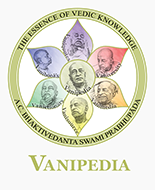 #div class="mw-parser-output"#
#h4##span class="mw-headline" id="TEXT_223"#TEXT 223#/span##/h4#
#div class="verse"#
#dl##dd#malaya-parvate kaila agastya-vandana#/dd#
#dd#kanyā-kumārī tāṅhāṅ kaila daraśana#/dd##/dl#
#/div#
#h4##span class="mw-headline" id="SYNONYMS"#SYNONYMS#/span##/h4#
#div class="synonyms"#
malaya-parvate — in the Malaya Hills; kaila — did; agastya-vandana — obeisances to Agastya Muni; kanyā-kumārī — Kanyā-kumārī; tāṅhāṅ — there; kaila daraśana — visited.
#/div#
#h4##span class="mw-headline" id="TRANSLATION"#TRANSLATION#/span##/h4#
#div class="translation"#
Śrī Caitanya Mahāprabhu then went to Malaya-parvata and offered prayers to Agastya Muni. He then visited Kanyā-kumārī [Cape Comorin].
#/div#
#h4##span class="mw-headline" id="PURPORT"#PURPORT#/span##/h4#
#div class="purport"#
The range of mountains in South India beginning at Kerala and extending to Cape Comorin is called Malaya-parvata. Concerning Agastya, there are four opinions: (1) There is a temple of Agastya Muni in the village of Agastyampallī in the district of Tanjoreāñ. (2) There is a temple of Lord Skanda on a hill known as Śiva-giri, and it is supposed to have been established by Agastya Muni. (3) Some say that near Cape Comorin there is a hill known as Paṭhiyā, which was supposed to have served as Agastya Muni's residence. (4) There is a place known as Agastya-malaya, which is a range of hills on both sides of the Tāmraparṇī River. Cape Comorin itself is known as Kanyā-kumārī.
#/div#
#/div# #div class="mw-parser-output"#
#h4##span class="mw-headline" id="TEXT_223"#TEXT 223#/span##/h4#
#div class="verse"#
#dl##dd#malaya-parvate kaila agastya-vandana#/dd#
#dd#kanyā-kumārī tāṅhāṅ kaila daraśana#/dd##/dl#
#/div#
#h4##span class="mw-headline" id="SYNONYMS"#SYNONYMS#/span##/h4#
#div class="synonyms"#
malaya-parvate — in the Malaya Hills; kaila — did; agastya-vandana — obeisances to Agastya Muni; kanyā-kumārī — Kanyā-kumārī; tāṅhāṅ — there; kaila daraśana — visited.
#/div#
#h4##span class="mw-headline" id="TRANSLATION"#TRANSLATION#/span##/h4#
#div class="translation"#
Śrī Caitanya Mahāprabhu then went to Malaya-parvata and offered prayers to Agastya Muni. He then visited Kanyā-kumārī [Cape Comorin].
#/div#
#h4##span class="mw-headline" id="PURPORT"#PURPORT#/span##/h4#
#div class="purport"#
The range of mountains in South India beginning at Kerala and extending to Cape Comorin is called Malaya-parvata. Concerning Agastya, there are four opinions: (1) There is a temple of Agastya Muni in the village of Agastyampallī in the district of Tanjoreāñ. (2) There is a temple of Lord Skanda on a hill known as Śiva-giri, and it is supposed to have been established by Agastya Muni. (3) Some say that near Cape Comorin there is a hill known as Paṭhiyā, which was supposed to have served as Agastya Muni's residence. (4) There is a place known as Agastya-malaya, which is a range of hills on both sides of the Tāmraparṇī River. Cape Comorin itself is known as Kanyā-kumārī.
#/div#
#/div# |
 #div class="mw-parser-output"#
#h4##span class="mw-headline" id="TEXT_223"#TEXT 223#/span##/h4#
#div class="verse"#
#dl##dd#malaya-parvate kaila agastya-vandana#/dd#
#dd#kanyā-kumārī tāhāṅ kaila daraśana#/dd##/dl#
#/div#
#h4##span class="mw-headline" id="SYNONYMS"#SYNONYMS#/span##/h4#
#div class="synonyms"#
malaya-parvate — in the Malaya Hills; kaila — did; agastya-vandana — obeisances to Agastya Muni; kanyā-kumārī — Kanyā-kumārī; tāhāṅ — there; kaila daraśana — visited.
#/div#
#h4##span class="mw-headline" id="TRANSLATION"#TRANSLATION#/span##/h4#
#div class="translation"#
Śrī Caitanya Mahāprabhu then went to Malaya-parvata and offered prayers to Agastya Muni. He then visited Kanyā-kumārī [Cape Comorin].
#/div#
#h4##span class="mw-headline" id="PURPORT"#PURPORT#/span##/h4#
#div class="purport"#
The range of mountains in South India beginning at Kerala and extending to Cape Comorin is called Malaya-parvata. Concerning Agastya, there are four opinions: (1) There is a temple of Agastya Muni in the village of Agastyampallī, in the district of Tanjore. (2) There is a temple of Lord Skanda on a hill known as Śiva-giri, and this temple is said to have been established by Agastya Muni. (3) Some say that the hill near Cape Comorin known as Paṭhiyā served as Agastya Muni’s residence. (4) There is a place known as Agastya-malaya, which is a range of hills on both sides of the Tāmraparṇī River. Cape Comorin itself is also known as Kanyā-kumārī.
#/div#
#/div# #div class="mw-parser-output"#
#h4##span class="mw-headline" id="TEXT_223"#TEXT 223#/span##/h4#
#div class="verse"#
#dl##dd#malaya-parvate kaila agastya-vandana#/dd#
#dd#kanyā-kumārī tāhāṅ kaila daraśana#/dd##/dl#
#/div#
#h4##span class="mw-headline" id="SYNONYMS"#SYNONYMS#/span##/h4#
#div class="synonyms"#
malaya-parvate — in the Malaya Hills; kaila — did; agastya-vandana — obeisances to Agastya Muni; kanyā-kumārī — Kanyā-kumārī; tāhāṅ — there; kaila daraśana — visited.
#/div#
#h4##span class="mw-headline" id="TRANSLATION"#TRANSLATION#/span##/h4#
#div class="translation"#
Śrī Caitanya Mahāprabhu then went to Malaya-parvata and offered prayers to Agastya Muni. He then visited Kanyā-kumārī [Cape Comorin].
#/div#
#h4##span class="mw-headline" id="PURPORT"#PURPORT#/span##/h4#
#div class="purport"#
The range of mountains in South India beginning at Kerala and extending to Cape Comorin is called Malaya-parvata. Concerning Agastya, there are four opinions: (1) There is a temple of Agastya Muni in the village of Agastyampallī, in the district of Tanjore. (2) There is a temple of Lord Skanda on a hill known as Śiva-giri, and this temple is said to have been established by Agastya Muni. (3) Some say that the hill near Cape Comorin known as Paṭhiyā served as Agastya Muni’s residence. (4) There is a place known as Agastya-malaya, which is a range of hills on both sides of the Tāmraparṇī River. Cape Comorin itself is also known as Kanyā-kumārī.
#/div#
#/div# |

 Compare previous verse
|
Compare next verse
Compare previous verse
|
Compare next verse 
